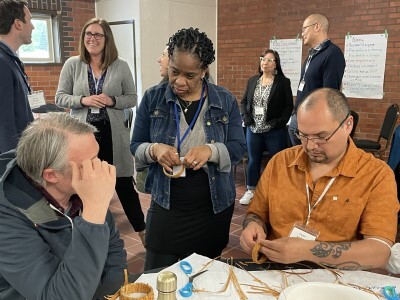Are You a Change Leader or a Change Manager?
Topics

Next generation learning is all about everyone in the system—from students through teachers to policymakers—taking charge of their own learning, development, and work. That doesn’t happen by forcing change through mandates and compliance. It happens by creating the environment and the equity of opportunity for everyone in the system to do their best possible work.
As leaders, we are often called upon to address change. I wanted to understand the distinction between managing change and leading it.
As leaders, we are often called upon to address change. I wanted to understand the distinction between managing change and leading it.
For this reason, I recently participated in an ELI online course, “Success-proof your change initiative,” conducted by Holly Morris, Director of Postsecondary Model Development and Adoption at EDUCAUSE. Change management is a frequent topic of conversation within the Leading Academic Transformation community and among EDUCAUSE colleagues.
I learned through the course that a change manager is responsible for the process, for articulating the sequence of steps and actions required of responsible parties to achieve results. Change management might be likened to project management in this relatively orderly process and structure. Meanwhile, a change leader is responsible for the vision, for inspiring and influencing faculty, staff, students, or other stakeholders to exert effort to change for the greater good--efforts which may not seem to be in their immediate best interests. (How many of us truly like change?) The change manager and change leader work together to realize change initiative success.
Reflecting on change initiatives of past decades, I have new appreciation for the roles of change leader and change manager. One example stands out particularly well by way of illustration. As a newly appointed director of instructional technologies at a small institution some years ago, I knew the capital improvement process for academic technology implementation was ripe for change. I also knew that the potential for conflict was significant in a place with a long history of academic discipline-based influence and departmental autonomy.
Convinced of the need for change nonetheless, I gathered and analyzed technology implementation data, which told a compelling story of uneven distribution and access to technology-enhanced teaching and learning spaces that was, in some cases, quite stark. In my experience, as in step 1 of John Kotter’s process for change management, data analysis is key to developing a sense of urgency for change.
Consulting with department chairs and other faculty leaders, senior administrators and my peers, I developed a more holistic approach to learning space management and capital improvement investments. The new process engaged all academic disciplines, the library, the registrar, facilities operations and IT in identifying, vetting, prioritizing, planning and executing classroom capital improvements. This broad-based coalition (step 2) was critical to our success and conveniently aligned with Kotter’s process by subsequently developing strategic vision (step 3), getting buy-in (step 4), and removing barriers to success (step 5).
The online course experience provided a great opportunity to reflect and gain fresh appreciation for the roles of the change manager and change leader in all of this work. At the time of launching the change initiative, I was very new to the position and quite new to the institution, still building reputation and political capital. No matter how necessary the change or how rational the plan, success hinged on the dynamic duo of change management and change leadership. Although I didn’t recognize it in these terms at the time, our change leader was the dean of academic affairs. In Holly’s terminology, he scripted the “why” language: Why are we doing this? Why us? Why now? His well-respected voice of experience and position of authority was essential to success at an institution steeped in tradition.
As change manager, my responsibility was for the “how:” How will we get from ‘now to wow’? The solution, a process dubbed “classroom stewards,” proved effective in achieving short term wins (step 6), assisting in acceleration (step 7) and implementing change (step 8). Within a few years, we had dramatically improved access to technology-enhanced teaching and learning spaces across campus. I’m pleased to discover that the process is still in place, although the current iteration is much improved from those early efforts. (Learn more about Kotter's 8 step process here.)
I was surprised to learn that change initiative success statistics are so dismal. According to Kotter, more than 70 percent of all major transformation efforts fail! In part, Kotter ascertains this is because that organizations do not take a consistent, holistic approach to changing themselves. Looking back on the classroom stewards initiative, I am grateful that the elements for a successful change initiative were present and available. I’m especially thankful for a strong change leader at the helm. A thank-you note is long overdue.




